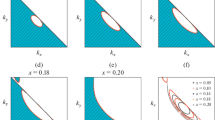Abstract
The nonlinear Schrödinger equation with Gaussian convolution kernel K2 induces the group SU3 with reference to the classification of the multiplet structure of the eigenstates. Such a field can be used to describe some atoms (where the outermost electrons are related tos-orbitals) as a self-interacting, extended particle with an internal structure. In the case of those atoms, where the valence electrons are described byp-orbitals, and almost all molecules the Gaussian kernel K2 has to be generalized by Hermite polynomials. By that, we can formulate a nonlinear field theory, establishing the spatial symmetry of a system via basis structure functions. Thus the symmetry represents the most essential starting-point for treating molecules as quasi-particles with an internal structure. It will be shown that there is some connection with the concept of chirality functions and the Ginzburg — Landau theory of super-conductivity. The latter theory indicates that we can consider the nonlinear Schrödinger equation and its generalizations as a classical field theory being associated with phase transitions.
Similar content being viewed by others
References
Zakharov, V., Shabat, A.: Sov. Phys. JETP,64, 1627 (1973)
Satsuma, J., Yajima, N.: Prog. Theor. Phys.55S, 285 (1974)
Kubo, S., Namiki, M., Ohba, I.: Prog. Theor. Phys.55, 860 (1976)
Jackiw, R.: Rev. Mod. Phys.49, 681 (1977)
Gupta, M. R.: Phys. Lett.72A, 6, 420 (1979)
Nonlinear Problems. Lecture Notes in Physics98, Heidelberg: Springer Press: 1979
Ulmer, W., Hartmann, H.: Nuovo Cimento47A, 359 (1978)
Ulmer, W.: Nuovo Cimento51A, 309 (1979)
Yamamoto, H.: Prog. Theor. Phys.58, 1014 (1977)
Ruch, E., Schönhofer, A.: Theoret. Chim. Acta (Berl.)10, 91 (1968)
Ruch, E.: Angew. Chem. Int. Ed.16, 65 (1977)
Hund, F.: Materie als Feld. Heidelberg: Springer Press 1954
Mielnik, B.: Com. Math. Phys.37, 221 (1974)
Hartmann, H., Stürmer, W.: Z. Naturforsch.5a, 99 (1950)
Huber, W., Simon, G., Kuhn, H.: Z.Naturforsch.17a, 99 (1962); Seelig, F., Huber, W., Kuhn, H.: Z. Naturforsch.17a, 114 (1962)
Meixner, J.: J. Math. Phys.4, 154 (1963)
Kohler, M.: Int. Journ. Theor. Phys.13, 38 (1975)
Roman, P.: Int. Journ. Theor. Phys.16, 12, 915 (1977)
Faiman, D., Hendry, A. W.: Phys. Rev.173, 1720 (1968)
Landolt-Börnstein: Atom- und Molekularphysik. Heidelberg: Springer Press 1950
Lakshmanan, N., Prabhakaran, J.: Lett. Nuovo Cimento7, 689 (1973)
Bender, C. M.: Phys. Rev.,D7, 1620 (1973)
Shustov, A. P.: J. Phys. A,11, 1171 (1978)
Halpern, F. R.: J. Math. Phys.14, 219 (1973)
Mizrahi, M. M.: J. Math. Phys.20, 844 (1979)
Hartmann, H., Ilse, F.: Z. Naturforsch.6a, 751 (1951)
Schläfer, H. L., Gliemann, G.: Einführung in die Ligandenfeldtheorie. Frankfurt am Main: Akademische Verlagsgesellschaft 1967
Landau, L. D., Ginzburg, V. L.: Sov. Phys. JETP,20, 1064 (1950)
Graham, R., Haken, H.: Z. Physik,237, 31 (1970)
Feynman, R. P.: Les Houches Lectures in Theoretical Physics, p. 163 1976
Heisenberg, W.: Z. Physik,96, 473 (1935)
Elliott, J. P.: The Nuclear Shell Model and its Relation with Other Models. Wien: International Atomic Energy Agency 1963
Meyer, M. G., Jensen, J. H. D.: Elementary Nuclear Shell Theory. New York: Wiley 1955
Barut, A. O., Raczka, R.: Nuovo Cimento,31B, 19 (1976)
Ivanenko, D. D.: In: Centenario Einsteiniano. Firenze: 1979
Feynman, R. P.: Photon-Hadron-Interaction. New York, N.Y.: 1972
Ulmer, W.: Z. Naturforsch.34c, 658 (1979)
Author information
Authors and Affiliations
Rights and permissions
About this article
Cite this article
Ulmer, W. On the representation of atoms and molecules as self-interacting field with internal structure. Theoret. Chim. Acta 55, 179–205 (1980). https://doi.org/10.1007/BF00556156
Received:
Issue Date:
DOI: https://doi.org/10.1007/BF00556156




